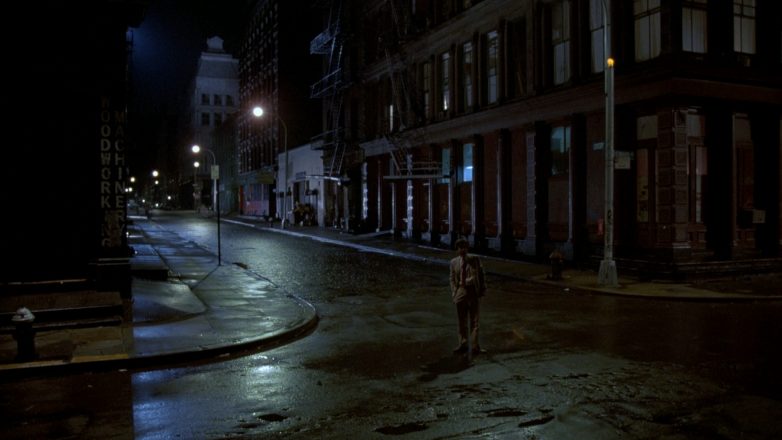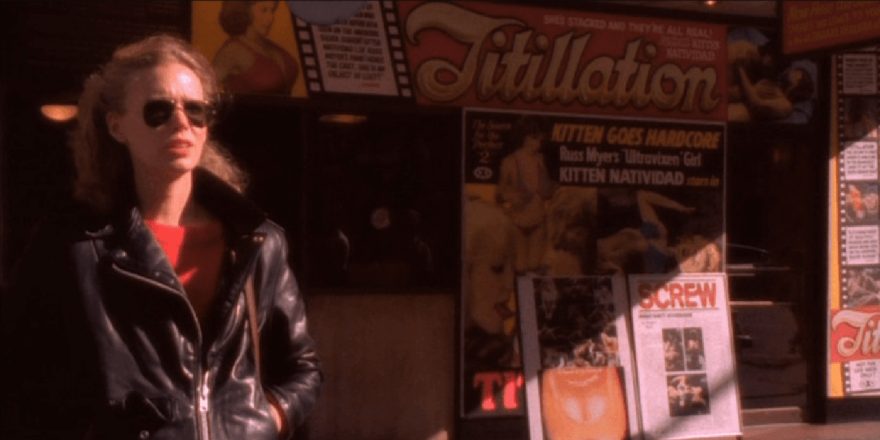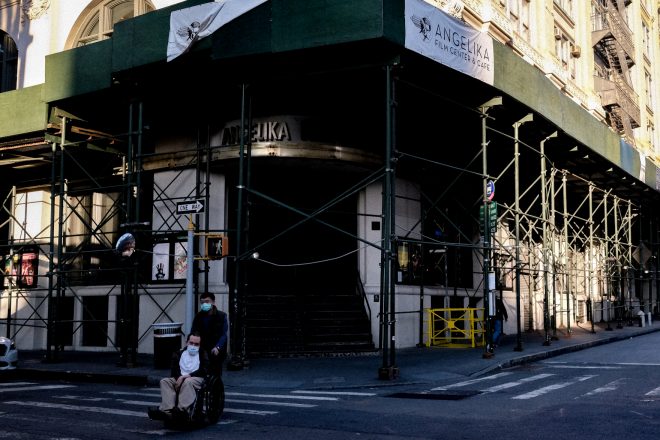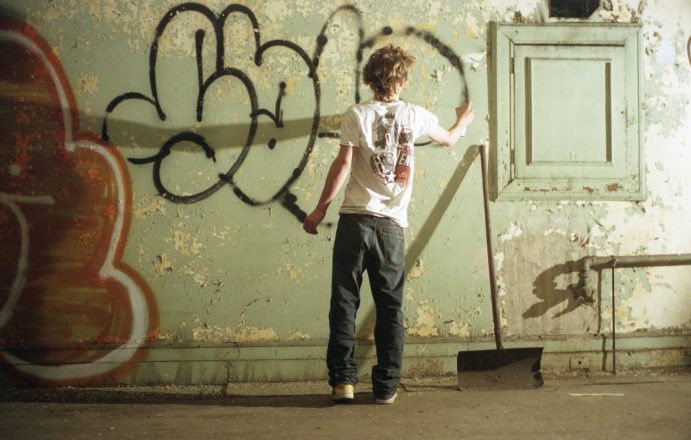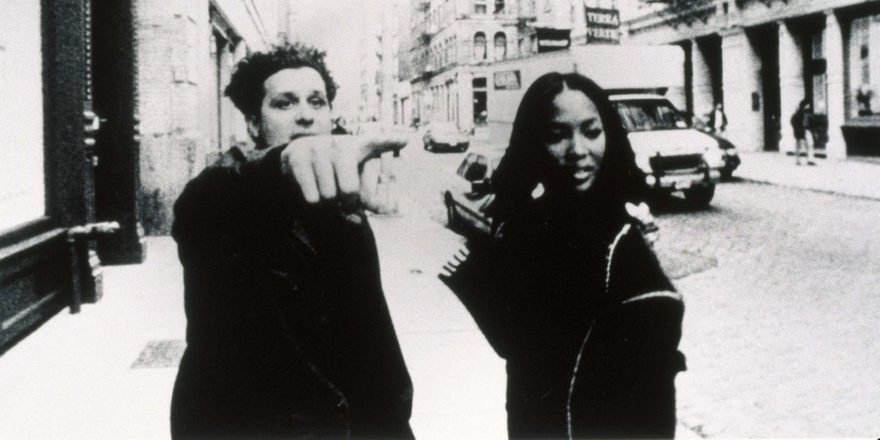Paul Hackett (Griffin Dunne) in Martin Scorsese’s film After Hours (1985) is standing on my corner – Howard and Crosby Streets – in downtown New York.
I lived at 21 Howard St. in the second floor loft from the late ’70s to the early ’90s. In Scorsese’s After Hours – a dark, tragicomic movie about an uptight, uptown computer programmer who finds himself in a nightmarish, inescapable “downtown” world as he pursues a woman – Paul Hackett, played by Griffin Dunne, walks toward my side of the street to ring the bell of her artist friend’s loft. This was my view of the outside world. I spent hours looking at it and filmed it often, especially the cobblestoned corner.
Howard Street is named after Henry Howard, a New York City firefighter and the chief of the fire department from 1857 to 1860. It’s one of the shortest streets in New York City, three short blocks running from Mercer Street to Centre Street, with only Broadway, Crosby and Lafayette in between, spanning Soho to Chinatown. We were east of Soho and north of Canal, so we weren’t (back then) technically part of Soho. We were north of Tribeca and neither in Chinatown nor Little Italy, yet blocks from them. We could buy essentials at a Korean fruit store at Crosby and Grand, cappuccino in Little Italy, egg creams at 24-Hour Dave’s Luncheonette at Canal at Broadway, run out at any hour of the night for soup in Chinatown. Everyone’s favorite bar was the Prince Street Bar in Soho. The closest club, the Mudd Club, was a few blocks south, on White Street.
Artists lived side by side with manufacturers on Howard Street in cast-iron buildings dating back to the 19th century. My next-door neighbor, at 19 Howard, was E. Vogel Custom Made Shoes & Boots, established in 1879. They displayed a single, expensive riding boot in the window and hung an oval sign of a painted boot in front of the building. It appeared modest, but its patrons – even then – were celebrities. The Putnam Rolling Ladder Co., founded in the 1930s, was directly across the street at 32 Howard. They literally made rolling ladders.
Above the A.I.R. (Artists in Residence) units in my building, a Chinese sweatshop churned out cheap clothes and dumped remnants at night on Howard. Canal Street, parallel to Howard, was its “back end” and restaurants ran all the way through from one street to the other, like a tunnel. They, too, dumped their garbage – food scraps. Along with their garbage bags came the rats, more than usual for New York. I owned glue traps, snap traps and a BB gun to shoot them as they scurried in the walls. I don’t know if I ever hit any.
At night, after the manufacturers closed, freight elevators clanging, we would have the streets to ourselves. Filmmakers, artists, musicians, theater people. Christo and Jeanne-Claude lived on Howard, on the other side of Broadway, in what they called a “miserable loft.” They were older, established and felt like royalty to us. Indie filmmaker Mark Rappaport and Scott and Beth B lived a few buildings north on Crosby. (The writer of After Hours, Joe Minion, worked as a production assistant on Scott and Beth’s 1982 film Vortex, starring Lydia Lunch.) A pre-fame Basquiat lived further up Crosby, near Houston, with Madonna. Of course, dozens of artists lived in Soho and Tribeca. Clubgoers from the vicinity on their way to the Mudd Club often walked down Crosby, turning on my corner at Howard before taking the left onto Broadway. They came back the same way in the pre-dawn hours, just before the squealing, groaning garbage pickup trucks arrived at 5 a.m.
The corner of Howard and Crosby felt safe, although Mark Rappaport remembers seeing cars burning further down Crosby from his top-floor loft. Safety was relative. Straight white artists didn’t have to worry too much, but lesbian and gay couples at the time found Italian streets more dangerous at night than the “artists blocks.” Women walking alone were naturally hassled, so we walked with mace in our bags (not that we ever used it) and keys interlaced in our fingers (not that we ever punched anyone out). Everyone had felt safer in Soho before six-year-old Etan Patz was abducted in 1975. Curtis and Lisa Sliwa created the Guardian Angels in 1979. Crime was bad enough by 1984 that Bernard Goetz was the big story of the year when he shot four young Black men who hassled him in the subway. Still, Howard itself felt safe, because it was a short street, the corner was open-ended and because of the bums (their choice of word) who drank on the stoop. They were there because of Honey, an actress from my 1983 film Born in Flames, who drank with them. The bums became the guardian angels of the corner.
When Scorsese shot After Hours, Honey negotiated for my loft to be used for a night as a holding area for the actors. That was fine with me – I loved Scorsese’s films. All I remember now is Teri Garr’s beehive being endlessly sprayed and fluffed. Other filmmakers in the area weren’t so happy about Scorsese taking over our ’hood. Rappaport, a few buildings up Crosby, shooed gaffers from his top-floor fire escape. Scorsese tells the story of someone yelling down from a building, “Is this going to go on all night?” during a pivotal scene where Paul cries to the universe, “Do I have to die for this?” Scorsese begged for two more takes.
I had a rented editing machine in my loft, which I sub-rented at $25 an eight-hour session. The night sessions were usually taken by young New York University students resembling Paul Hackett – terrified of the streets, unfamiliar with the city. Honey, from the projects in Brownsville, Brooklyn, would walk them back up to NYU, then hang out on the stoop with the bums. I sometimes filmed her with them from my window for Born in Flames.
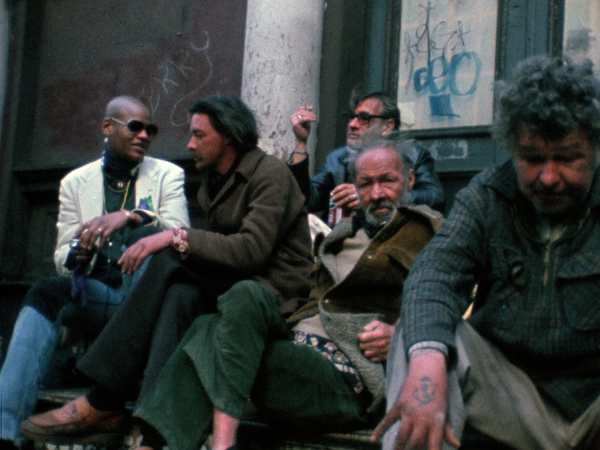
The bums were in front of my loft the night Honey, Adele Bertei and a couple of other women from my film spontaneously began to sing “No Woman, No Cry” a cappella, using the sides of cars as percussion. I dangled a microphone from the window to record it. In the background, the bums on the corner called out, “God bless! God bless!” like a Greek chorus.

I was tickled to hear After Hours cinematographer Michael Ballhaus, in the commentary for the film, talk about making friends with “the bums,” and how interesting their stories were. Honey’s people had been “seen” by others.
For Paul, the corner of Howard and Crosby is the first step in a journey to Hades in what Ballhaus calls a “horror movie,” beginning with a set of keys being hurled at him, then encountering Kiki (Linda Fiorentino) making “art.”
When After Hours first came out, I thought Kiki’s papier maché art piece hilarious – a 3-D interpretation of Munch’s “The Scream,” made from wheat paste. Wheat paste played a big role in our lives. We knew its visceral, snotty feeling by heart. Pre-social media, it was the only way to advertise our no-budget events. We plastered every pole in the area. Wheat paste fliers also played a big role in looking for criminals. When Etan Patz disappeared. When Ana Mendieta went out the window, although everyone knew who did it.
Other details in the film also resonate: Gail (Catherine O Hara) carries a comically oversized whistle; some of us did carry whistles, albeit smaller, back in the day. The rat traps around Julie’s (Teri Garr) bed are also comically right – multiply that by 100. A dozen garbage bags adorn various corners in the film. Multiply that by 1,000. Hackett jumps a turnstile, sees a transit cop, hops back with no consequence. Honey – Black – talked back to a couple of transit cops at the same station and was beaten so severely, she was hospitalized.
Paul was merely a few blocks from Little Italy when he was deposited by taxi at the corner of Howard and Crosby, at the beginning of the film. As Scorsese tells Fran Liebowitz in the supplement for the new Criterion Blu-ray of After Hours, there would have been no story if Paul had walked uptown, out of his nightmare. Or, by extension, if he knew how close he was to the safety of Mulberry Street, a few blocks east.
Watching After Hours now, I am especially nostalgic seeing my corner exactly as it was when I lived there. The film brings back an even longer span of lost time than just the mid ’80s, the history of the first gentrifiers transforming raw spaces into livable spaces “downtown.” I love seeing the emptiness of the streets as Hackett runs from his pursuers. Today, Howard is still a manufacturing street. E. Vogel Custom Made Shoes & Boots and the Putnam Rolling Ladder Company are still there. But, at night, Howard and Crosby are overrun by hordes of outsiders, beckoned by the blazing lights of the high-end boutiques and department stores on Broadway, tourists who sleep in the grand hotels on Crosby or the more modest Holiday Inn on Howard. Some artists still cling to their rent-controlled A.I.R. spaces, but the magic of the corner is gone, along with Honey and her bums.
Featured image of Griffin Dunne in After Hours courtesy the Criterion Collection; images from Born in Flames courtesy Lizzie Borden. Find this and many other New York stories in the first issue of the Talkhouse Reader, which you can pre-order here.



